We here at FlatSixes.com can’t stress enough the importance of properly inflated tires and how underinflated or overinflated tires can affect your car’s performance. We’ve already covered our recommendations for the best portable tire inflators, which will allow you to properly inflate your tires from the comforts of your own home. But sometimes it’s inconvenient to setup your tire inflator just to check your tire pressure and that’s where a tire pressure gauge comes in handy.
If your car is already equipped with the technology to display your actual tire pressure, then you likely don’t need a tire pressure gauge. Still, you may want to own one if you often go to the track and need to quickly grab an accurate tire pressure reading. Now, if your vehicle only has a tire pressure monitoring system (TPMS) and doesn’t give you a display of your actual tire pressure, then you’ll want to invest into a tire pressure gauge. Reason being, your TPMS is programmed to only alert you when your tire pressure drops below a certain threshold, which is typically 25 percent below the recommended pressure. If you care about your tire’s longevity and your car’s fuel economy, you don’t want to wait for an alert to know that your tires are underinflated. Your TPMS is better used as a warning of a fast leak or a flat tire, while a tire pressure gauge will let you know when you’re just a few PSI off.
Below, you’ll find our recommendations for the best tire pressure gauges. Pricing on these can vary, but for the most part, they’re relatively affordable. We give recommendations for all three types of tire pressure gauges currently available: dial, digital, and stick (pencil). If you want to learn more about tire pressure gauges, we also have more information about them following our top picks.
1. Best dial gauge: JACO Elite tire pressure gauge
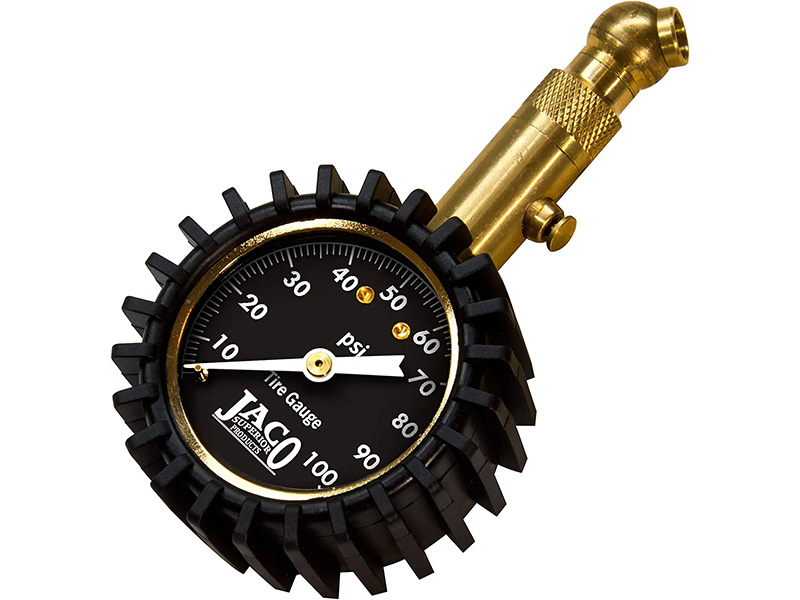
If you want a proper, reliable tire pressure gauge that can accurately read up to 100 PSI, JACO Elite’s tire pressure gauge is our recommendation. While most Porsche owners won’t need a tire reading up to 100 PSI, it surely doesn’t hurt to have the capability if you ever need it. This is a dial gauge and has been performance tested, certified, and calibrated to meet or exceed ANSI B40.1 standards, meaning it’s accurate within plus or minus 1.5 percent. Since it is a dial gauge, you don’t have to worry about needing batteries — it’s ready whenever you need it.
We like this gauge because it’s extremely durable, with a rugger construction and a shock-resistant rubberized protective guard. The 2.25″ brass stem makes checking tire pressure easy, and there’s a built-in air bleeder valve so you can easily reduce pressure if your tires are overinflated. The air chuck at the end sits on a 360-degree swivel, so you can comfortably get to your tire valve. This dial tire pressure gauge measures 2″ in diameter and glows in the dark. The reading locks into place until the pressure reset button is pushed.
More importantly, this is our top pick because JACO is a well-respected brand within the off-road industry and has been selling parts since 1983. Our experience with its customer support has been positive and the company stands behind its products.
Check Price on Walmart
Check Price on eBay
2. Best digital gauge: AstroAI digital tire pressure gauge
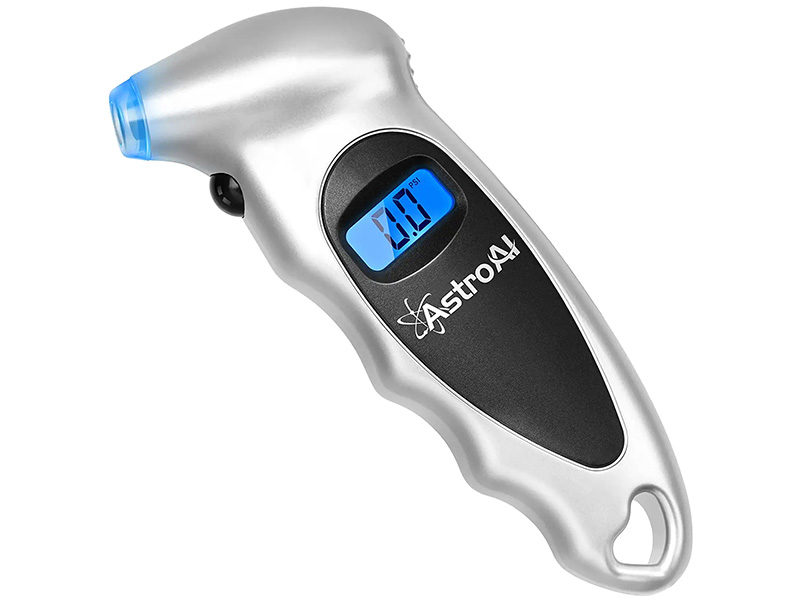
If you prefer a digital tire pressure gauge and can deal with needing batteries, our recommendation goes to AstroAI’s digital tire pressure gauge. Truth be told, many of the digital tire pressure gauges out there are very similar, so we prefer a brand that has a reputation for solid customer service in case you get a faulty one. Most are manufactured overseas and there’s always the chance of getting a dud, so you’ll want to make sure you’re buying from a reputable brand.
AstroAI’s digital tire pressure gauge is generally very accurate, assuming you get a good unit. It’s affordable, reliable, and will display tire pressure in four different units (PSI, BAR, kg/cm², or KPA). The company does include a battery with each gauge, but we recommend having a couple spares lying around. Along with a backlit LCD display, the nozzle itself can also illuminate to help you measure your tire pressure in a dark environment.
I personally recommend digital tire pressure gauges to people who live in an area where there are extreme temperatures, since digital gauges tend to be more accurate than analog ones in those conditions.
Check Price on Walmart
Check Price on eBay
3. Best stick gauge: Valve-Loc pencil tire pressure gauge
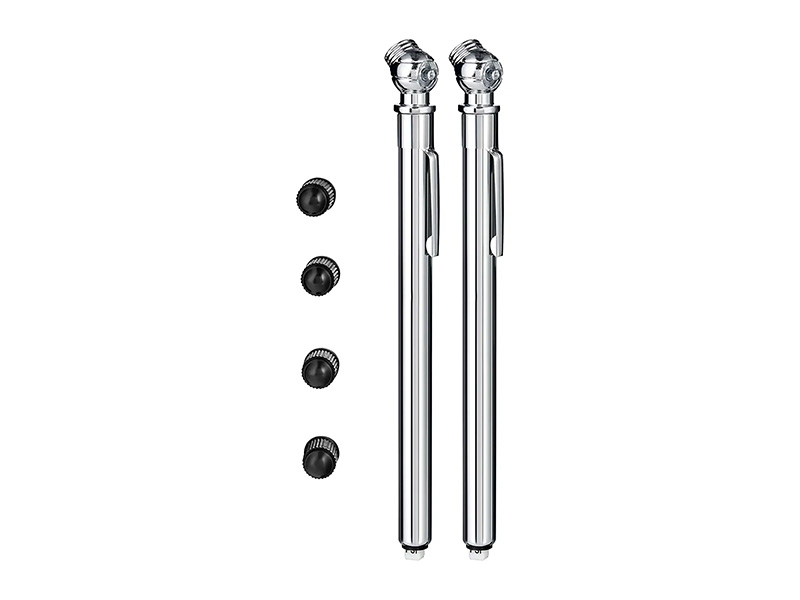
This is more than likely the tire pressure gauge your parents used when you were a kid, and that’s a stick gauge (also known as a pencil gauge). If you’ve never used one of these, they’re very basic in design — you simply connect the chuck to your tire’s valve and the stick pops out, giving you a tire pressure reading. This type of gauge is simple, compact, and the most affordable tire pressure gauge out there. They are a bit more difficult to read compared to digital and dial gauges, but they still do the job.
If you really want a stick gauge, this two-pack from Valve-Loc is my recommendation. They read up to 50 PSI and feature heavy duty chrome and stainless steel construction. The company even includes four black valve stem caps in case you need replacements.
There are those who swear by the accuracy of stick gauges and prefer them over modern designs. If you’re one of those people, here’s the recommendation for you.
Check Price on Walmart
Check Price on eBay
4. Also consider: VONDIOR tire pressure gauge
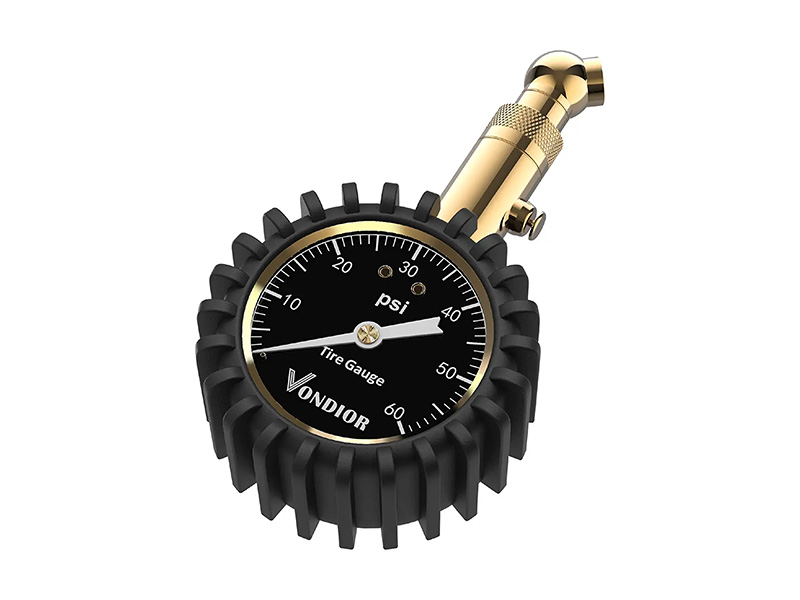
If you prefer the design of a dial gauge and want something more affordable than our JACO Elite recommendation, take a look at VONDIOR’s tire pressure gauge which is often on sale. It’s very similar in style with a rubberized protective outer shield, but this gauge can only read up to 60 PSI — which should be more than enough for most Porsche owners. The company says it’s been highly calibrated to be accurate within one percent.
Measuring 2″ in diameter, it too has a glow-in-the-dark dial with a 2.25″ brass stem and a 360-degree swivel chuck. Overall, this analog tire pressure gauge is very similar to our top pick, other than its max 60-PSI reading. We still prefer JACO as a brand, as they have a solid reputation for taking care of its customers.
Check Price on Walmart
Check Price on eBay
5. Honorable mention: Slime digital sport tire pressure gauge
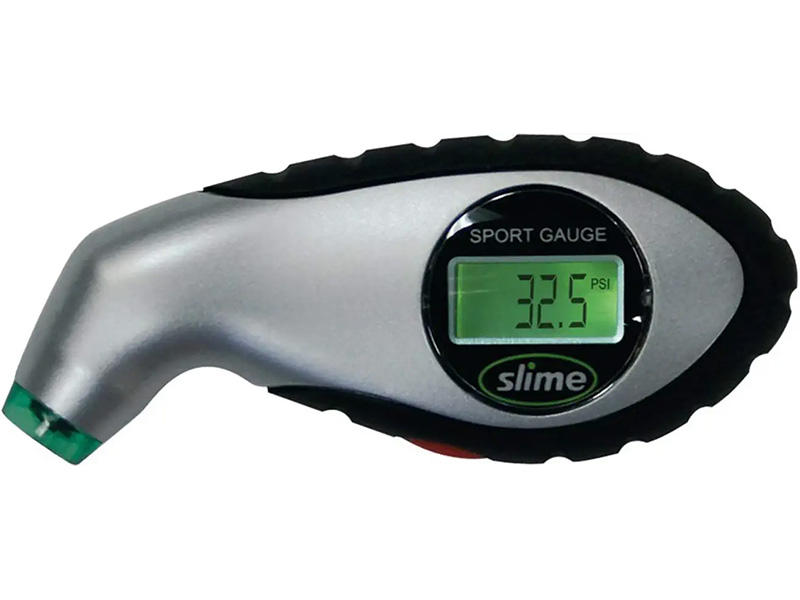
Our final recommendation is a digital tire pressure gauge from manufacturer Slime. The brand has been selling tire care products since 1989, so it knows the importance of proper tire pressure. The gauge itself is pretty run-of-the-mill when it comes to digital tire pressure gauges, with a backlit LCD display, lighted nozzle, and the ability to measure up to 150 PSI. It’s being recommended for its reputation within the industry for solid customer support.
Check Price on Walmart
Check Price on eBay
The different types of tire pressure gauges
There are three main types of tire pressure gauges: dial, digital, and stick. Here’s a quick breakdown of each type.
Dial gauges are analog tire pressure gauges that are round and resemble a clock. It uses a needle to indicate tire pressure and generally they’re very easy to read. These gauges are popular among off-roaders and track enthusiasts, since they typically have a built-in bleeder valve so you can easily take pressure out of the tire while measuring. The biggest concern with dial gauges are how accurate they are in extreme temperatures and their durability. Some analog gauges won’t be accurate if they’re accidentally dropped.
Digital gauges feature an LCD or LED display that shows your tire pressure in an easy-to-read format. Generally, digital gauges are more resistant to the environment and the recommended type for the average car owner. They’re easy to use and understand, but they do require batteries.
Stick gauges are also known as pencil gauges and are widely considered the “old school” tire pressure gauge. They’re very basic in design and are the most affordable of the three types of gauges.
Which tire pressure gauge is most accurate?
Unsurprisingly, there are plenty of arguments over which type is most accurate and we believe so long as you’re buying a quality product that has been properly calibrated, it’ll be accurate enough. Personally, I do believe digital tire pressure gauges are the most accurate since they can stay calibrated more reliably than an analog gauge. The calibration on digital gauges is done using software, which means it should be more precise if done properly. You should also get a more accurate measurement from a digital gauge in extreme temperatures.
How to check your tire pressure
Using a tire pressure gauge is fairly straightforward and doesn’t require any mechanical knowledge. Here are the basic steps to follow, regardless of the type of gauge you purchased:
- 1. Always check your tire pressure when the tires are cold, meaning your car has been parked for three hours or more. Warm tires are inflated, which means you won’t get an accurate measurement since the manufacturer’s recommended tire pressure is for cold tires.
- 2. Locate your recommended tire pressure by checking your driver’s side door jamb for a decal. If it’s not there, it could also be on your fuel door or your glovebox. If you still can’t find it, check your owner’s manual. Note that you could have different recommended tire pressures for your front and rear tires.
- 3. Use your tire pressure gauge to check the tire pressure by connecting the chuck to your valve stem once you remove the valve stem caps. You’ll want to press down hard enough until the “hissing” sound disappears and your gauge gives you a measurement.
- 4. Write down each measurement from your tires so you know which ones are underinflated or overinflated. Use a portable tire inflator to properly inflate your tires if they’re underinflated, or let some air out if they’re overinflated.
How often should I check my tire pressure?
We recommend checking your tire pressure monthly. It should only take you a few minutes, and I tend to do it after washing my car. A monthly check will help ensure you’re getting proper fuel economy and your tires aren’t experiencing premature wear.
Recent updates:
Updated (1:02 p.m. EST, 1/27/23): Added more shopping options for our recommendations.
